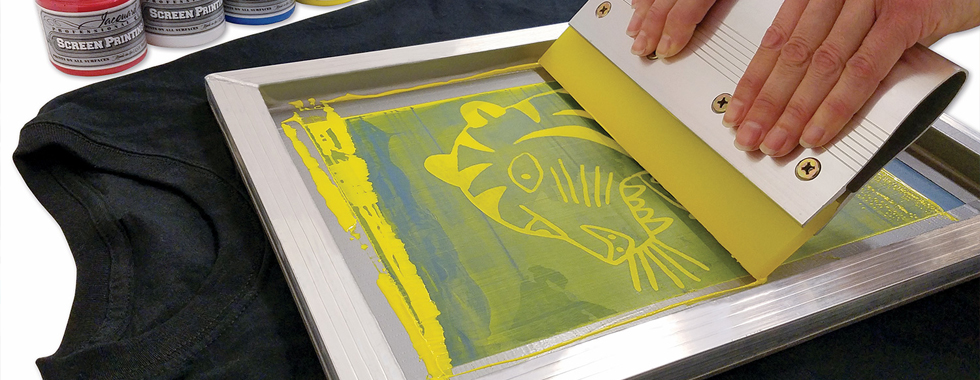ChatGPT said: 10:9 Design reviews: uncovering the strengths and weaknesses
Wiki Article
The Essential Guide to Comprehending Screen Printing and Its Versatile Makes use of
Screen printing has a rich history that dates back to ancient times, evolving into a sophisticated method made use of throughout numerous markets today. This overview explores the intricacies of the screen printing process, outlining its applications in home, fashion, and advertising and marketing decoration - 10:9 Design LLC Company. Comprehending these basics can open creative possibility for both imaginative and industrial jobs. The complying with areas will reveal necessary ideas and strategies to boost one's screen printing venturesThe History of Screen Printing
Screen printing has origins that trace back centuries, its evolution reflects the technical and creative developments of numerous cultures. Stemming in old China, the technique was originally made use of for enhancing fabrics and later spread to Japan, where it came to be integral to Ukiyo-e woodblock printing. The method changed to Europe in the 18th century, where it got popularity amongst artisans and commercial printers. The creation of picture solution in the 20th century transformed screen printing, permitting for more elaborate layouts and greater efficiency. Musicians like Andy Warhol even more thrust its appeal, using the medium to create famous jobs that combined commercialism and fine art. By the late 20th century, screen printing had developed itself as a flexible technique, utilized in fashion, marketing, and art. Today, it remains to evolve, incorporating electronic innovation and broadening its applications throughout numerous markets.The Screen Printing Refine Explained
Screen printing transforms imaginative visions into concrete designs with a series of accurate actions. An image is produced and then moved onto a screen, usually made of great mesh material extended over a framework. A light-sensitive solution is related to the screen, which is subjected to light, setting in locations not covered by the image. After rinsing the unhardened solution, a pattern is created.Next, the screen is positioned over the substratum, whether it be fabric, paper, or an additional product. Ink is after that pushed via the open areas of the stencil using a squeegee, transferring the style onto the substrate below. This procedure can be duplicated for multiple colors, requiring separate screens for every tone. Lastly, the published thing is treated making use of heat to guarantee the ink sticks correctly, causing a sturdy, dynamic style all set for usage.
Types of Screen Printing Techniques

Furthermore, specialty strategies, such as discharge screen printing, eliminate color from the fabric to create softer prints, while foil screen printing uses metal foil to attain a shiny surface (10:9 Design Screen Printing Texas). Each strategy provides distinct qualities, satisfying different innovative requirements and manufacturing scales, ultimately expanding the opportunities within the screen printing domain name
Applications of Screen Printing in Different Industries

Additionally, the signs and advertising and marketing fields use screen printing for developing attractive screens and banners. This approach allows for strong shades and detailed layouts that record focus. In electronic devices, screen printing is used for applying conductive inks to circuit card, crucial for element connections. Moreover, the home style market accepts screen printing to produce unique styles on fabrics and wall surface art. Overall, screen printing acts as an important device throughout varied areas, boosting products with individualized and aesthetically appealing graphics.
Tips for Successful Screen Printing Projects
While embarking on a screen printing project, cautious attention to information can considerably enhance the last result. Initially, choosing premium materials is essential; this consists of the screen, inks, and substrates. Utilizing appropriate mesh matters can impact ink deposition and detail resolution. Prep work is just as important; thorough get more info cleansing of screens and correct exposure times assure crisp prints.Next, exact registration is critical for multi-color prints. Using placement tools can aid attain specific layering. Furthermore, screening prints on scrap materials before production assists determine prospective concerns without losing resources.

Often Asked Concerns
What Products Are Ideal for Screen Printing on Textile?
Cotton and polyester blends are suitable for screen printing on fabric because of their toughness and ink absorption. Furthermore, specialized materials like silk or canvas can produce unique appearances and surfaces, boosting the overall design high quality.Just how Do I Tidy and Maintain Screen Printing Tools?
To keep and clean screen printing devices, one need to frequently wash displays with ideal solvents, examine squeegees for wear, lubricate relocating components, and shop all items in a dry, dust-free setting to lengthen their life-span.What Are the Environmental Impacts of Screen Printing?
Screen printing can have substantial environmental effects, consisting of chemical waste from solvents and inks, water usage during cleaning processes, and power consumption. Sustainable techniques and environment-friendly products are crucial for reducing these unfavorable results.Can Screen Printing Be Done at Home Successfully?
Screen printing can be effectively done at home with the right materials and strategies. Enthusiasts can develop top quality prints, though success depends upon their skill level, tools, and understanding of the procedure entailed.
What Are the Expenses Connected With Starting a Display Printing Business?

Starting a screen printing organization includes costs for tools, materials, and work space. Preliminary costs generally vary from a few hundred to a number of thousand dollars, depending upon the scale, top quality of machinery, and desired manufacturing capability.
Screen printing has an abundant history that dates back to old times, evolving into an innovative technique used throughout numerous industries today. One more strategy, rotary screen printing, utilizes round screens, promoting constant printing on textile rolls, thereby improving performance for large-scale productions. Furthermore, specialized techniques, such as discharge screen printing, get rid of color from the material to develop softer prints, while foil screen printing uses metal aluminum foil to accomplish a glossy surface. In the style field, screen printing is commonly utilized to create vivid styles on garments, making it possible for brand names to showcase their distinct styles. Cotton and polyester blends are optimal for screen printing on material due to their longevity and ink absorption.
Report this wiki page